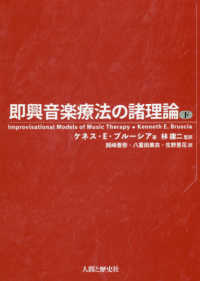Full Description
The right to the peaceful enjoyment of property is one of the most frequently invoked rights in the European Convention on Human Rights (ECHR). It is also one of the most complex and least understood. Through the Convention's history, the protection of the right to property has undergone significant development in the case law of the European Court of Human Rights. This book shows how the Court's reliance on the Convention's object and purpose - in particular the rule of law - has served as the main impetus for development. Based on a comprehensive analysis of the jurisprudence, the book analyses the arguments and clarifies the principles governing human rights protection of property rights.
Contents
Contents
Series Editors' Preface
Acknowledgements
PART 1
1 Introduction
1 Jurisprudential Developments in the Right to the Peaceful Enjoyment of Property
2 Structure and Outline
3 Selection of Materials
2 The Genesis of Protocol 1 Article 1
1 The Convention
2 The First Additional Protocol
3 Conclusion
3 Aspects of the Court's Teleology
1 Introduction
2 The Principle of Effectiveness
3 Evolutive Interpretation
4 The Convention's Fundamental Values
4.1 Human Dignity
4.2 Democracy and Political Freedom
4.3 The Rule of Law
PART 2
4 The Autonomous Property Concept
1 Introduction
2 Conceptual Analysis - Property as Rights and Assets
2.1 A Substantive Guarantee of the Right to Property
2.2 The Two 'Axes' of the Property Concept
2.3 The Relationship between Property Rights in the Convention and in Domestic Law
3 Rights in Property Protected by Protocol 1 Article 1
3.1 Elements of Ownership
3.2 Limited Rights in Property
4 Assets Constituting 'Possessions' for the Purposes of Protocol 1 Article 1
4.1 'All Kinds of Pecuniary Assets'
4.2 The Court's Approach to Intangible Assets
5 Protection of Legitimate Expectations
5.1 A Notable Expansion of Protocol 1 Article 1's Material Scope
5.2 Expectations Linked to Existing Property Rights
5.3 A Separate Form of Expectations Linked to the Realisation of Claims?
5.4 The Rationale for Protecting Legitimate Expectations under Protocol 1 Article 1
6 Conclusion
5 Protection of Whose Property Rights?
1 Introduction
2 The Starting Point: 'Every Natural or Legal Person'
3 Limitations Derived from the Court's Jurisdiction
4 Limitations Derived from the Convention's Enforcement Machinery
4.1 The 'Victim' Requirement
4.2 'Non-Governmental Organisations'
5 Conclusion
6 The Merits of the Court's 'Three Rules' Approach
1 Introduction: The Notion of Interference in Convention Rights in General and the Right to Property in Particular
2 Characteristics of Deprivation of Property
3 Control of the Use of Property
4 The General Principle
5 Conclusion
PART 3
7 The Three Dimensions of the Court's Justification Assessment
8 Substantive Dimension: A Heightened Level of Scrutiny
1 Introduction: The 'Fair Balance' Requirement, Its Legal Basis and Construction
2 A Conceptual Approach to Proportionality
2.1 Suitability
2.2 Strict Necessity
2.3 Proportionality in the Strict Sense
2.4 The Structure of the Court's Substantive Assessment under Protocol 1 Article 1
3 The Weight of the Public Interest
4 Effects on the Applicant
4.1 Economic Effects
4.2 Non-Economic Effects
5 The Issue of Compensation
5.1 A Material Factor in the Court's 'Fair Balance' Assessment
5.2 The Market-Value Standard
5.3 Public Interests Justifying Compensation below Market Value
5.4 The Reference to 'General Principles of International Law'
5.5 Compensation for Interference Not Constituting Deprivation
6 The Applicant's Legitimate Expectations and Acceptance of Risk
6.1 A Relative Standard of Legal Certainty
6.2 The Problem of Retroactive Laws
7 The Conduct of the Parties
8 Conclusion
9 Institutional Dimension: Towards 'Deeper Subsidiarity'?
1 Introduction: The Two Functions of the 'Legitimate Aim' Test
2 The Margin of Appreciation, Its Legal Basis and Functions
3 Arguments for Deferential Review in Cases concerning the Right to Property
3.1 Structural Arguments: Proximity, Consensus and Legitimacy
3.2 The Nature of the Public Interest
4 Conclusion
10 Procedural Dimension: Protocol 1 Article 1 as a Guarantee against Arbitrary Interference
1 Introduction
2 The Principle of Lawfulness
3 Legal Certainty
4 Access to Effective Proceedings
4.1 The Basis and Rationale for Protocol 1 Article 1's Procedural Safeguards
4.2 Availability of Proceedingsbr/>
4.3 Effectiveness of Proceedings
5 Safeguards against Arbitrariness at the Domestic Level
5.1 Fairness in Proceedings
5.2 The Quality of the Assessments Made by Domestic Authorities - Revisiting the Court's Process-Based Review
6 Conclusion
PART 4
11 The Evolving Scope and Justification of the Right to Property in the ECHR
1 The Court's Expansive Approach to Protocol 1 Article 1's Scope of Protection
2 The Dynamics of the Court's Justification Assessment
12 The Right to Property and the Rule of Law in the ECHR System
1 Contextualising the Developments
2 The Court's Search for Legitimacy in Cases concerning the Right to Property
3 The Convention's Preeminent Object and Purpose 207 Case Law
Case Law
Bibliography
Index







